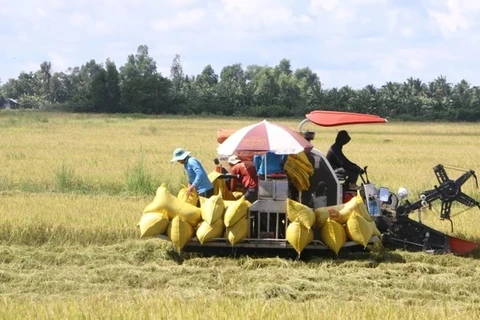Hau Giang (VNA) – Continuing to restructure the rice sector towards higher quality and value is among the measures recommended to boost rice exports in the coming time.
The Ministry of Agriculture and Rural Development (MARD) coordinated with the People’s Committee of the Mekong Delta province of Hau Giang to hold a workshop on December 13 to look into the global rice market and trends in the time ahead. The event was part of the Vietnam - Hau Giang International Rice Festival 2023.
MARD Deputy Minister Tran Thanh Nam said the agricultural sector is working to train farmers in sustainable practices, to form a safe, sustainable and competitive supply chain for the sector. He proposed a policy to build a national brand for the rice sector, and develop the agricultural extension staff to improve capacity for farmers.
In the time ahead, the ministry will continue working with relevant ministries and agencies to create mechanisms and conditions for forming rice value chain connectivity in not only the country but also the region and the world, he went on.
The MARD is implementing a project on sustainably developing 1 million ha of specialised high-quality and low-emission rice farming in association with green growth in the Mekong Delta by 2030.
Hau Giang has registered 46,000ha for the project, Chairman of the provincial People’s Council Tran Van Huyen said, describing the project as a practical move showing Vietnam as a responsible country contributing to a transparent, responsible, and sustainable global food system.
Le Thanh Hoa, Deputy Director of the MARD’s Department of Quality, Processing and Market Development, noted that favourable conditions for Vietnam’s rice exports include effective Government policies, restriction of supply sources such as India, maintenance of traditional markets, and the high potential of new markets.
However, he also pointed out some of the difficulties in the sector. These include unstable supply due to the crop structure, climate change, and limited sale connectivity, along with the shortage of preservation and processing infrastructure and technology, strong competition, increasing protectionism and technical barriers, lower consumption due to economic uncertainty and high inflation, and price volatility.
He also underlined the need to strengthen cooperation in producing high-quality grains while changing the structure of rice varieties cultivated to diversify export markets in conformity with the strategy for developing rice export markets of Vietnam until 2030.
In 2023, the rice farming area nationwide was 7.1 million ha with productivity expected at 6.07 tonnes of unmilled rice per ha. The total output was at 43.1 million tonnes, rising about 0.4 million tonne from last year. Some 7.8 million tonnes of milled rice was exported during the first 11 months of this year to bring home an estimated 4.4 billion USD in revenue, according to the MARD./.
The Ministry of Agriculture and Rural Development (MARD) coordinated with the People’s Committee of the Mekong Delta province of Hau Giang to hold a workshop on December 13 to look into the global rice market and trends in the time ahead. The event was part of the Vietnam - Hau Giang International Rice Festival 2023.
MARD Deputy Minister Tran Thanh Nam said the agricultural sector is working to train farmers in sustainable practices, to form a safe, sustainable and competitive supply chain for the sector. He proposed a policy to build a national brand for the rice sector, and develop the agricultural extension staff to improve capacity for farmers.
In the time ahead, the ministry will continue working with relevant ministries and agencies to create mechanisms and conditions for forming rice value chain connectivity in not only the country but also the region and the world, he went on.
The MARD is implementing a project on sustainably developing 1 million ha of specialised high-quality and low-emission rice farming in association with green growth in the Mekong Delta by 2030.
Hau Giang has registered 46,000ha for the project, Chairman of the provincial People’s Council Tran Van Huyen said, describing the project as a practical move showing Vietnam as a responsible country contributing to a transparent, responsible, and sustainable global food system.
Le Thanh Hoa, Deputy Director of the MARD’s Department of Quality, Processing and Market Development, noted that favourable conditions for Vietnam’s rice exports include effective Government policies, restriction of supply sources such as India, maintenance of traditional markets, and the high potential of new markets.
However, he also pointed out some of the difficulties in the sector. These include unstable supply due to the crop structure, climate change, and limited sale connectivity, along with the shortage of preservation and processing infrastructure and technology, strong competition, increasing protectionism and technical barriers, lower consumption due to economic uncertainty and high inflation, and price volatility.
He also underlined the need to strengthen cooperation in producing high-quality grains while changing the structure of rice varieties cultivated to diversify export markets in conformity with the strategy for developing rice export markets of Vietnam until 2030.
In 2023, the rice farming area nationwide was 7.1 million ha with productivity expected at 6.07 tonnes of unmilled rice per ha. The total output was at 43.1 million tonnes, rising about 0.4 million tonne from last year. Some 7.8 million tonnes of milled rice was exported during the first 11 months of this year to bring home an estimated 4.4 billion USD in revenue, according to the MARD./.
VNA

























